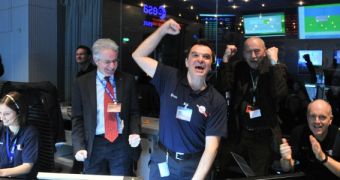The image above shows controllers of the European Space Agency's (ESA) Rosetta mission cheering yesterday, January 20, 2014. Moments before the photo was snapped, the team had just received the first signals from the spacecraft after 31 months spent in hibernation. The probe was put in this mode to conserve energy in July 2011.
The joy was overwhelming at the ESA Space Operations Center (ESOC) in Darmstadt, Germany, particularly because the space probe got in contact with Earth during its first window of opportunity. The signal was recorded loudly and clearly by two NASA tracking stations, in the US and Australia.
The spacecraft is currently flying around 807 million kilometers (501.4 million miles) away from the Sun, but it still has an additional 9 million kilometers (5.6 million miles) to go before it arrives at its destination, the comet 67P/Churyumov–Gerasimenko
Rosetta is the first spacecraft that will enter orbit around a comet, the first probe to send a lander to the surface of a comet, and the first to move alongside a comet around the Sun. The vehicle also carried the instrument-laden Philae lander, which will be conducting studies from the surface of the comet itself.

 14 DAY TRIAL //
14 DAY TRIAL //